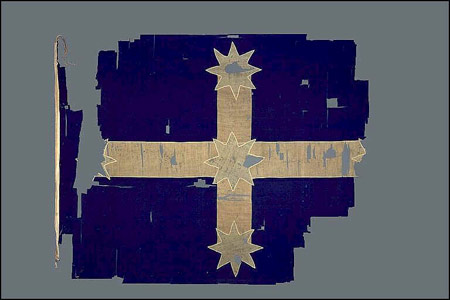The Eureka flag is set on a dark blue field with a horizontal white stripe and a veritcal white line crossing it with five eight pointed white stars - one on each of the four ends of the two lines and one in the centre of the flag. The stars represent the Crux Australis consetallation. According to Frank Cayley's book "Flag of Stars", the white cross joining the stars symbolises unity in defiance.
The Eureka flag is said to have been designed by Captain Henry Ross, a member of the Ballarat Reform League of Canadian origin. It is also said that the flag was sewn together by three local women - Anastasia Withers, Anastasia Hayes and Anne Duke.
The Eureka flag was first used in 1854 as the flag of the Eureka Rebellion in Ballarat, Victoria, Australia. Miners swore allegiance to the flag as a symbol of defiance. The first flying of the flag is said to have been on 29 November 1854 at Bakery Hill. The Eureka Rebellion itself took place on 3 December 1854
The original Eureka flag was lent to the Museum of Australian Democracy at Eureka by the Art Gallery of Ballarat; however, the Museum closed in 2018. The design was listed as an object of state heritage significant by the Victorian Heritage Register and as a Victorian Icon by the National Trust in 2006.
The Eureka flag has gained popularity in Australian culture as a symbol of egalitarianism, democracy and protest. The flag is particularly popular with many trade unions and their members, notably the Construction, Forestry, Maritime, Mining and Energy Union (CFMMEU).

The original Eureka flag
 WARNING - Flag Bazaar flags are lightweight and are not suitable for extended use on flagpoles
WARNING - Flag Bazaar flags are lightweight and are not suitable for extended use on flagpoles